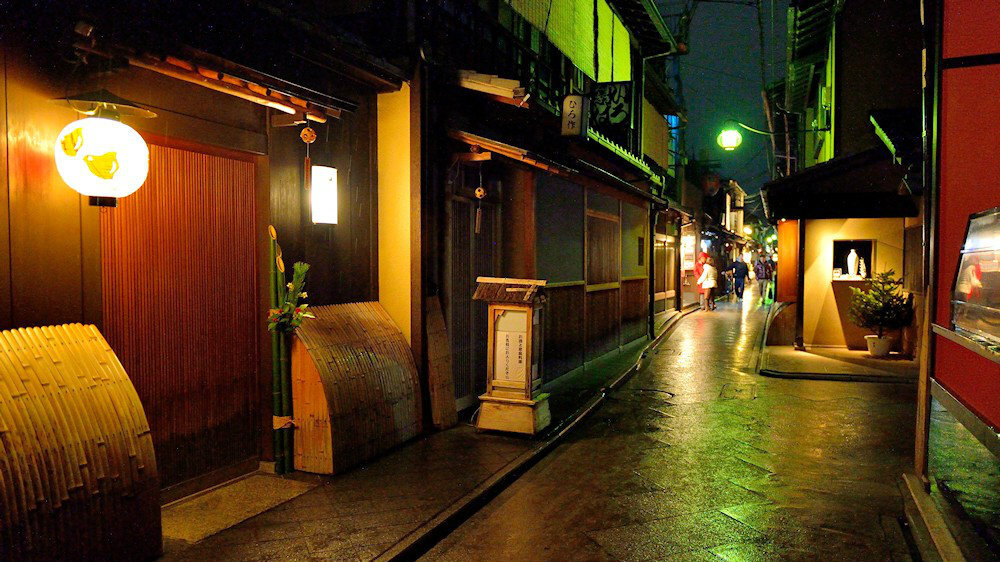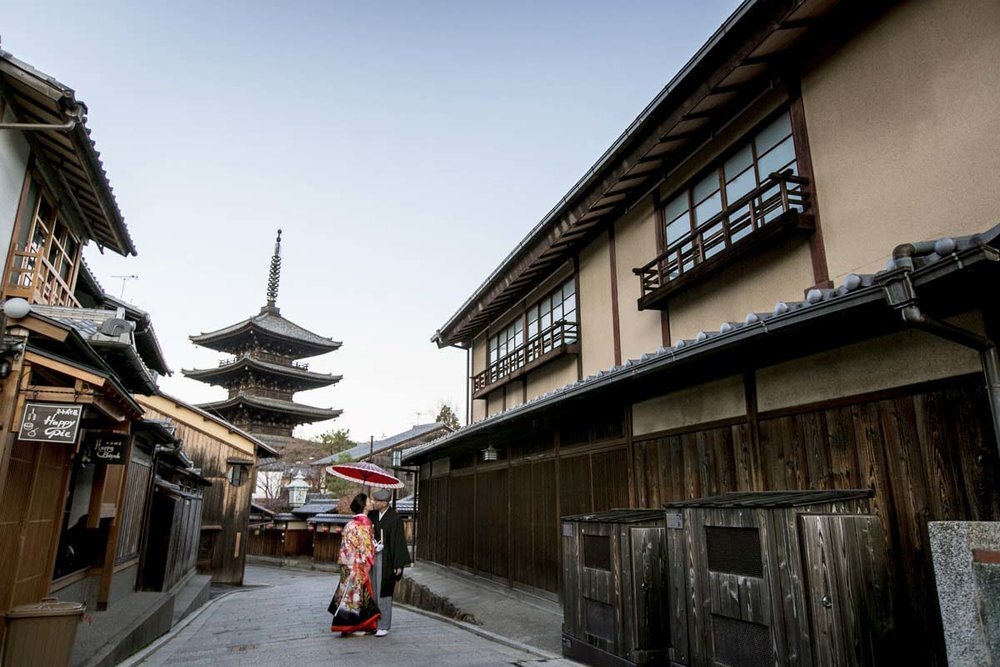
Discover Gion
OUR LOCAL AREA
What's around Machiya Maya Gion?
Gion is the historical heart of Kyoto, there is no shortage of wonderful experiences to indulge in! Your Kyoto experience starts here.
“The perfect base for exploring Kyoto.”
Gion
Hanami-koji Street
GION - 1 MINUTE WALK
Hanamikoji Dori, Higashiyama Ward, Kyoto Prefecture, Japan
The best place to see geisha in Kyoto is Hanami-koji on the south side (Kenninji Temple side) of Shijo-dori. A stroll through in the evening will usually yield at least one sighting. The street and side alleys are lined with preserved machiya houses, many of which now function as restaurants, serving Kyoto style kaiseki ryori (Japanese haute cuisine) and other types of local and international meals. Interspersed among the restaurants are a number of ochaya, teahouses, the most exclusive and expensive of Kyoto's dining establishments, where guests are entertained by maiko and geiko.
Kennin-ji Temple
Zen Buddhist Temple & Art Gallery
KENNIN-JI TEMPLE - 1 MINUTE WALK
584 Komatsu-ch, Higashiyama-ku, Kyoto, Kyoto Prefecture
Kennin-ji was founded in 1202 CE and claims to be the oldest Zen temple in Kyoto.Kennin-ji is a historic Zen Buddhist temple at the end of Hanami Lane. It is considered to be one of the so-called Kyoto Gozan or "five most important Zen temples of Kyoto".
It houses the designated national treasure “Fujin-Raijin” (“The Wind and Thunder Gods”), a gold-leaf embellished screen painting by the 17th-century artist Tawaraya Sotatsu.
“Spacious and in the perfect location - quiet street within minutes walk of lots of sights.”
Yasaka Shrine
Shinto Shrine
YASAKA SHRINE - 8 MINUTE WALK
Yasaka Shrine, Higashiyama Ward, Kyoto Prefecture, Japan
Yasaka Shrine (Yasaka-jinja), once called Gion Shrine (Gion-jinja), is a Shinto shrine in the Gion District of Kyoto, Japan. Situated at the east end of Shijo-dori (Fourth Avenue), the shrine includes several buildings, including gates, a main hall and a stage.
Initial construction on the Shrine began in 656. The Shrine became the object of Imperial patronage during the early Heian period. In 965, Emperor Murakami ordered that Imperial messengers be sent to report important events to the guardian kami of Japan. Also the host of the Gion Matsuri.
“Traditional Japanese experience in great location!
Kiyomizu-dera is only a 15 minute walk, subway is close and a few smaller temples are around the corner. ”
Kiyomizu-Dera
World Heritage Temple with amazing views
KIYOMIZU-DERA - WORLD HERITAGE - 15 MINUTE WALK
Kiyomizu-dera, Higashiyama Ward, Kyoto Prefecture, Japan
Kiyomizu-dera officially Otowa-san Kiyomizu-dera is an independent Buddhist temple in eastern Kyoto. The temple is part of the Historic Monuments of Ancient Kyoto (Kyoto, Uji and Otsu Cities) UNESCO World Heritage site.
Kiyomizu-dera was founded in the early Heian period. The temple was founded in 778, and its present buildings were constructed in 1633, ordered by the Tokugawa Iemitsu. There is not a single nail used in the entire structure. It takes its name from the waterfall within the complex, which runs off the nearby hills. Kiyomizu means clear water, or pure water.
Minami-Za
Kabuki Theatre
MINAMI-ZA KABUKI THEATRE - 8 MINUTE WALK
Minami-za, Kyoto, Kyoto Prefecture, Japan
Minami-za is the primary kabuki theatre in Kyoto, Japan. It was founded in 1610 as Shij? Minami-za. The current building with 1,086 seats was built in 1929.Minami-za is one of the earliest of the seven officially licensed Kabuki theaters built in the early Edo period (1615-1623) in the Shijo Kawara area in Kyoto, even before Tokyo and Osaka.
The current Minami-za theater was built in 1929 in the architectural style of the Momoyama period, with a gabled roof and a traditional turret marking the official approval of the government. In 1991, after the end of the Showa period, the interior was drastically refurbished and modern stage mechanism was installed.
In 1996, Minami-za was registered as a Japanese Tangible Cultural Property in respects to its historical architectural value in connection to the city of Kyoto.
Nishiki Market & Shijo Street
Shopping and Dining
SHIJO-DORI STREET - 6 MINUTE WALK
Nishiki Market & Shijo-Dori , Kyoto-shi
Shijo Street (Shijo-dori) runs center of Kyoto, Japan east to west through the commercial center of the city. The street is particularly busy with pedestrians and traffic from the east end to Karasuma Street. The east end passes through the courtesan's district of Gion, with the historic street of Hanami Lane branching off to the south, with the famous Ichiriki Chaya at the corner. It then crosses the Kamo River at Shijo Bridge, and from there to Karasuma Street (Shijo Karasuma) the sidewalk is covered (except at major streets) and features several department stores, such as Daimaru and Marui. Off Shijo is Nishiki Market a very popular tourist attraction and is known to locals as “Kyoto’s pantry” the best traditional food market in the city.
Gion Corner
Cultural Performances & Art Gallery
GION CORNER - 2 MINUTE WALK
570-2 Gionmachi Minamigawa, Higashiyama-ku, Kyoto
Gion Corner is a place where you can take in seven kinds of performing arts, most notably kyo-mai dance performed by maiko dancers. Here you can see Japan's traditional performing arts in 'digest' form all on one stage. Located in Yasaka Hall next to the Gion Kobu Kaburenjo Theatre, the spot has a very international flavor, as it is popular with Japanese and foreign tourists.
Ponto-Cho
Entertainment & Bars District
PONTO-CHO - 12 MINUTE WALK
160-1 Matsumotocho (Pontocho), Nakagyo-ku, Kyoto-shi
Ponto-cho is a Hanamachi district in Kyoto, Japan, known for geiko and maiko and home to many geiko houses and traditional tea houses. Like Gion, Ponto-cho is famous for the preservation of forms of traditional architecture and entertainment.Ponto-cho centres around one long, narrow, cobbled alley running from Shijo-dori to Sanjo-dori, one block west of the Kamo River (Kamo-gawa). This is also the traditional location of the start of kabuki, and a statue of Okuni still stands on the opposite side of the river. This area was heavily featured in Arthur Golden's Memoirs of a Geisha.
Yasui Konpira Shrine
YASUI KONPIRA SHRINE - 1 MINUTE
70 Shimobentencho, Higashio-ji,Matsubara Agaru, Higashiyama-ku, Kyoto-shi
The history of the shrine begins at the time of reign of the 38th Emperor Tenchi (668 to 671 C.E.), when Kamatari Fujiwara established the shrine, to pray for prosperity of the clan and eternal continuation of his descendants. planted purple wisteria and called it Fujidera (The Temple of Wisteria).
And today it is where local people go to pray to get new charm and luck. The Yasui Konpira-gu Shrine is often referred to as the enkiri (separation) or enmusubi (marriage) stone. It’s said to have the power to break up or initiate relationships.
Yasaka Pagoda
Historical Landmark
YASAKA PAGODA - 12 MIN
Yasaka Pagoda
This pagoda is located close to the Kiyomuzi-Dera temple at the bottom on Sannen-Zaka, Ninen-Zaka Streets and is part of Hokan-ji Temple. The pagoda is 49 meters high. It is said that this pagoda was built in 592 by Shotoku-taishi, a prince in that period. This pagoda had been destroyed by fire and rebuilt several times. Current pagoda was rebuilt in 1440 by Yoshinori Ashikaga, the 6th Shogun of Muromachi government.
Kamogawa River
Historical Walking and Dining Location
KAMOGAWA RIVER - 7 MIN
Kawabata Dori, Miyagawasuji 1-chōme, Higashiyama-ku, Kyōto-shi
In the past, the Kamogawa river was a crucial source of drinking water for Kyoto residents and was used in the Kyoto style of dyeing, Kyo-Yuzen dyeing. The river banks are popular for walking not only during cherry blossoms in spring but also in summer, when restaurants open their balconies out onto the river.
Ninen-zaka & Sannen-zaka
Historical Neighborhood
NINENZAKA & SANNEN-ZAKA | 12 MINS
Just downhill from Kiyomizu-dera, you will find one of Kyoto’s loveliest restored neighbourhoods, the Ninen-zaka and Sannen-zaka area. The name refers to the two main streets of the area: Ninen-zaka and Sannen-zaka, literally ‘Two-Year Hill’ and ‘Three-Year Hill’. The years refer to the ancient imperial years when they were first laid out. These two charming streets are lined with old wooden houses, traditional shops and restaurants.
“We love this place! In fact, we want to live here”
Welcome Home
to your Machiya Maya Gion.
















